Travel in Sacred Myanmar
Golden Shrines, Roads Less Traveled, and Plenty of Smiles
Article and photos by Lies Ouwerkerk
Senior Contributing Editor
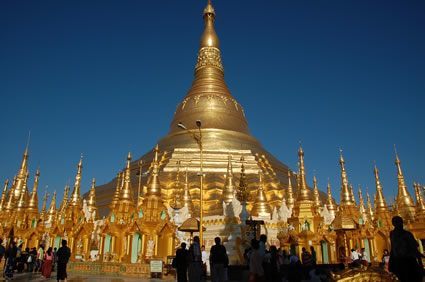
|
|
The magnificent Shwedagon Pagoda in Yangon.
|
Once you have read the biography From the Land of the Green Ghosts by Pascal Khoo Thwe, or the novel The Piano Tuner by Daniel Mason — both set in Myanmar, as Burma is now called — chances are you want to know more about the way of life of the people who inhabit this rather unknown S.E. Asian country. Unfortunately, many of the more than 100 ethnic minorities in Myanmar live in remote areas that are currently off-limits for foreigners, due to internal wars. There is another pressing dilemma in the minds of many: are we doing the Myanmar people a favor by visiting their impoverished country or not?
To Visit or Not to Visit?
Travel to Myanmar has been a controversial topic for decades. Since 1962, the country has been ruled by a xenophobic and oppressive military dictatorship that repeatedly violated human rights, and caused foreign governments and influential figures within the country to urge a boycott of tourism. Among them was Aung San Suu Kyi, the Burmese opposition leader under house arrest in her Yangon home until the fall of 2010, who argued that only the military regime would benefit from tourism’s income, not the local people. Since Myanmar’s political landscape has been changing recently, this view is largely abandoned.
How to Travel in Myanmar and Benefit the People
When you travel to Myanmar, the key is to choose private tour operators and family-owned establishments. In this way, government-owned businesses are largely bypassed and the people of Myanmar — one third of whom are still living below the poverty line — receive some tourist dollars and exposure to the outside world. “Please do come! We can learn from you, and you can learn about us,” insisted the many Burmese I interviewed. My Myanmar guide, a highly educated and knowledgeable man with an excellent command of English reflected: “Myanmar is still a long way from democracy. We desperately need foreign aid and know-how to help us become self-sufficient and catch up with the rest of the world.”
The Myanmar People
The warmth and hospitality of the Myanmar surprised and enchanted me. Soft-spoken and nearly always smiling, they went out of their way to please, while at the same time being very careful not to impose. In the countryside, we were more than once invited into locals’ modest wooden or bamboo dwellings to meet with their families and drink tea, and were offered the best seats in their sparsely furnished houses. In Mandalay and Yangon, we could easily strike up a chat with locals at the many roadside teahouses, where friends meet, business deals are sealed, and green tea is offered free of charge. Taxi drivers in cars, rickshaws, and carts pulled by oxen were always willing to go the extra mile with a smile. Mind you, saying “no” is one of the most difficult things for a Myanmar local to do, admitted my guide one day, so sometimes one needs to double-check in order to better understand the Myanmar’s real intention!
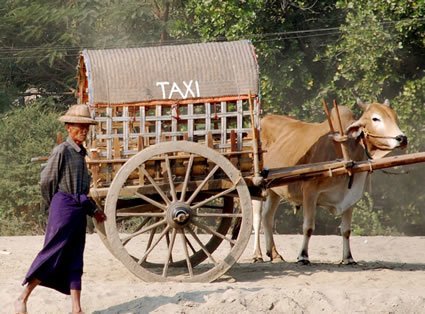
|
|
Taxi on the bank of the Irrawaddy river.
|
Many local people in Myanmar wear their traditional costume, the longhi, a plain or flowery sarong with a deep pleat in front for women, and a checked or striped sarong tied in a knot in front for men. Both men and women often wrap a colorful thin towel around their head in the form of a turban, or wear a colonial bamboo hat.
Especially eye-catching is the thanaka paste that women and children apply to their faces, and sometimes their arms, in order to prevent sunburn and control the oiliness of their skin. The paste is formed by mixing a few drops of water with a yellowish powder, ground from the bark of a thanaka tree.
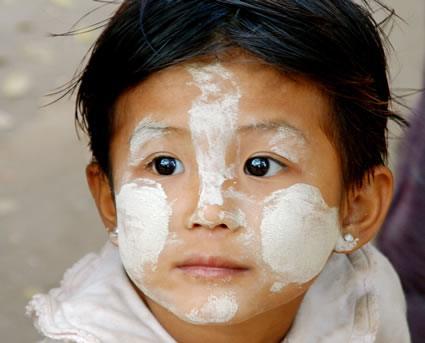
|
|
Child with thanaka paste applied to her face.
|
The Religions
Buddhism profoundly permeates Myanmar daily life, which is not surprising, as about 90% of Myanmar people are Theravada Buddhists. The remaining 10% of the population are made up of Christians and Muslims, and to a lesser extent of Hindus and animists. Gaining merit is an important motive in the actions of Buddhists in Myanmar, as they believe that by doing good deeds they will eventually attain Nirvana, their ultimate goal.
In order to attain Nirvana, Buddhists in Myanmar try to live according to the three main requirements:
-
charity (giving alms and food to monks, and caring for the sick and elderly)
-
morality (living according to the 5 precepts: not to kill living creatures, steal, lie, be sexually immoral, or use substance)
-
wisdom (acquired through meditation for instance)
Interestingly, the Hindu legacy of worshipping and offering to nats (spirits) revered before Buddhism entered Myanmar, still holds to this day and is not felt in conflict with the principles of Buddhism. The popularity of astrologers, clairvoyants, and palm readers is also significant. They are often consulted to establish good days and times for weddings, monk initiations, crucial life decisions, and to avert bad luck or disasters.
Ancient Temples, Monasteries, and Pagodas Galore
The prevalence of Buddhism is expressed in the many monasteries, temples, and pagodas — or zedis or payas — in particular around Yangon, Bagan, Bago, and Mandalay. The centuries-old Shwedagon in Yangon and the Maha Myat Muni in Mandalay, both erected to enshrine sacred hairs of the Buddha, are breathtaking with their many gold-colored spires shining in the bright sunlight, and are daily visited by monks, lay devotees, and pilgrims for prayer, offerings, and meditation.
The immense complex of hundreds of ancient temples, with the tall Ananda and Tatb-byin-nyu towering over the rest of them in a plain around Bagan, 400 miles north of Yangon, was so impressive that we rented bikes and wandered through the 20 square miles area for several days without seeing anybody else. Most of these temples — some of them still with colossal figures of buddhas and frescos intact, others ravaged by time — date back to the 12th and 13th centuries and were built by kings and queens when Bagan was the seat of the Myanmar dynasty and Theravada Buddhism became the religion of the state.
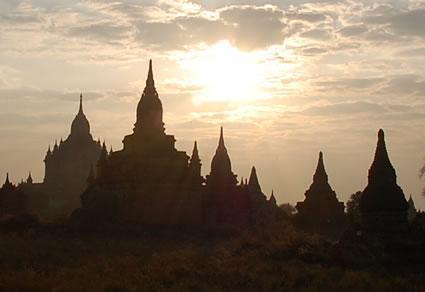
|
|
Bagan temple complex.
|
The Rituals of the Monks
Orderly processions of red-robed monks passing through their villages and towns in the early mornings to collect food, are a common street scene. Barefooted, hands clasped beneath their alms woks, and eyes to the ground or at infinity, I never saw them exchange a word nor thank their givers. It is the charitable who will gain merit and should be thankful for the opportunity to give!
After one or two hours, the monks return to the Spartan accommodations of their monastery, often outside the village away from noise and surrounded by well-foliaged trees. Portions of the alms are offered to the Buddha, and the rest consumed for breakfast. After the meal, the monks take on domestic duties such as washing out their alms bowls and sweeping floors, and meditate or read old texts.
Following the tradition of the Buddha and his son, who both entered the monastery as wealthy princes in their quest for enlightenment, every Myanmar Buddhist boy is more or less expected to become a novice monk for at least a short period in his life, varying from a few days to a few months. For his initiation, called shin-pyu, parents spend lavishly and often beyond their means, since having a son “take robe and bowl” brings great merit to their family.
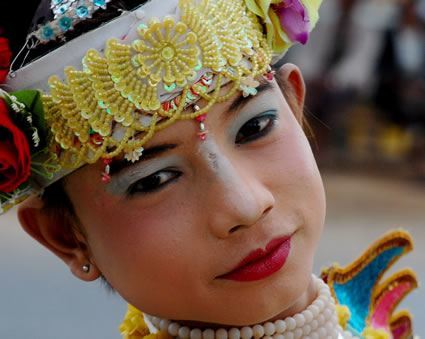
|
|
A boy dressed up for Shin-pyu, his monk initiation.
|
Mounted on horses or on someone’s shoulders, and protected against the sun by golden umbrellas, we saw many young novices between 7 and 12, all resembling princes of yesteryear, parade through their towns towards the local monastery, with family members, neighbors, and friends in tow. There, the novices’ heads are shaved, they are given robes, black lacquer alms bowls, and Pali (traditional language) names, and are initiated into the order as “sons of Buddha.” Only when they are 20 years old may they become ordained monks.
Girls can enter a nunnery, although this is less often done in Myanmar. Their heads are also shaved, and they wear pink robes. They do not go out on daily rounds with alms bowls, however, and they do not perform ceremonies on behalf of lay people.
Encounters with Local People
My most endearing memories remain the numerous encounters with the Myanmar locals. Monks not only solemnly meditating and fingering rosaries but also chatting under a flowering bougainvillea at their monastery compound, men in tea houses seated on low plastic stools exchanging their latest news, farmers ploughing with their ox-carts through the fields, and fishermen on Inle Lake navigating their boats with one leg. Women puffing on cheroots, hanging their laundry on poles in the narrow and nameless streets of ram-shackled Yangon, or selling fruits in the market using old-fashioned fly swappers and antiquated scales. There were happy thanaka-faced children playing with marbles or an old tire, and other children asking to be photographed without demanding anything in return.
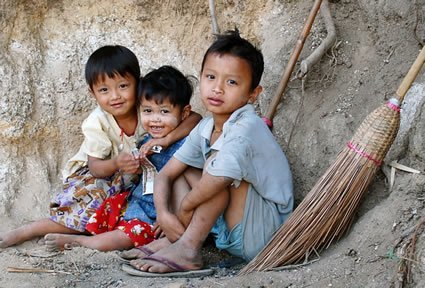
|
|
Happy children playing with nothing.
|
I also cherish fond memories of a ferry captain on the Irrawaddy river who said a prayer for all on board before taking off on the rickety vessel, of an old farmer who offered his house for some shade during a trek in the Kalaw mountains (and his curious neighbors watching silently from afar as they had never seen a foreigner before!), of a henna-haired vendor in Mandalay who served us an extra portion of his delicious banana chapattis free of charge, of a hermit near Nyaungswhe who proudly showed his tiny cave, and of a group of young female students who invited me to join their picnic at the Shwedagon Paya.
Such heartwarming experiences may not define Myanmar forever, though. Slowly, the quest for pencils, candies, and money is already infiltrating the major tourist sites in the country. My unequivocal advice to aficionados of the "authentic" is therefore: reconsider, and go now!
For More Info
-
A visa for 4 weeks can be obtained at foreign embassies. It helps to have a letter of a Myanmar travel agency.
-
Meals and hotels are relatively cheap: dinner averaged 3 – 8 dollars, and overnight stays 15 – 35 dollars.
-
Hotels accept both kyats and dollars. Bring enough cash, as there are no ATMs, and credit cards are nowhere accepted. Important: notes have to be crisp, without any wrinkles or marks.
-
There are no direct flights from the U.S. Best bet: fly to Bangkok, then continue to Yangon with Thai or Bangkok Airways.
|
Lies Ouwerkerk is originally from Amsterdam, The Netherlands, and currently lives in Montreal, Canada. Previously a columnist for The Sherbrooke Record, she is presently a freelance writer and photographer for various travel magazines.
|
